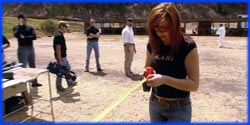


Premier Date: June 13, 2007
busted
Grant, who is susceptible to seasickness, volunteered to test self-hypnosis to see whether he could overcome his condition. As a control, he was put into a chair that helped induce seasickness while Tory and Kari kept track of how long it would take for him to vomit. Grant then used a self-hypnosis CD to try and cure his sickness. After his self-hypnosis session, Grant went back to the chair, but still succumbed to his sickness, although it took twice as long.
busted
Kari first went to an eye center to obtain a control photo of her eye color. She then underwent a self-hypnosis session in an attempt to change her physical eye color. However, when she went back to the eye center to have her eyes analyzed, the results showed that there was no change in eye color.
busted
Because Tory had no real issues that could be resolved through self-hypnosis, the Build Team instead brought Adam and tried to cure him of his irrational fear of bees. For the control test, they measured Adam’s heart rate and physical stress levels when he was shown a box full of bees and had to put his hand inside of it. After going through his self-hypnosis session, Adam retook the test. During the retest, Adam showed the same amounts of fear and physical stress as the control test, showing that he still possessed his fear.
busted
This myth is based on an internet video where a man ingested both Diet Coke and Mentos and fell unconscious, reportedly from a ruptured stomach. When tested with a pig’s stomach, it was learned that the simple act of drinking the soda released much of the carbon dioxide within it, preventing the expected cascade of foam the Mentos and soda combination would give off. Even pumping the gas from the normal Mentos/cola fountain directly into the stomach didn’t make the stomach burst, but like the previous myth of soda and Pop Rocks, the stomach expanded to the point where the victim would be in a lot of pain and induced vomiting. Only by blowing compressed air directly into the stomach did it burst.
confirmed
During the control test, the MythBusters detonated a grenade with no obstacles with several plywood dummies around it at varying distances. The shrapnel inflicted lethal injuries on most of the dummies. For the actual test, the MythBusters planted a ballistics gel dummy over the grenade before detonating it. While the ballistics gel dummy was completely destroyed, only one of the plywood dummies suffered any severe damage, and what damage was caused was not lethal. While the hero would undoubtedly die in the attempt, he would be able to save his comrades nearby.
confirmed
The MythBusters placed a grenade in a bucket full of water, in hopes that the bucket would slow down the shrapnel enough to inflict no harm on the plywood dummies. However, there were fears that the bucket would in fact contribute to the damage by being turned into shrapnel itself. After the test, only one of the dummies suffered lethal damage, but there was still significantly less shrapnel damage than the control test. Though not perfect, one advantage to this method is that the hero does not have to sacrifice himself.
busted
The MythBusters obtained a refrigerator and placed it in the middle of a group of the dummies. They then placed a grenade inside it and detonated it. The refrigerator was essentially turned into a giant fragmentation grenade, and the flying debris destroyed the dummies immediately in front and behind of the refrigerator, though standing at the sides is safe. The MythBusters agreed that putting a grenade in the refrigerator was not a good idea.
Previous: Episode 80: Big Rig Myths
Next: Episode 82: Snow Special